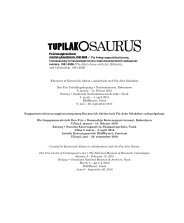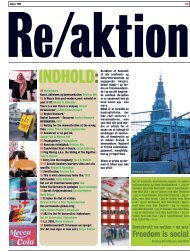tupilakosaurus - Print matters!
tupilakosaurus - Print matters!
tupilakosaurus - Print matters!
You also want an ePaper? Increase the reach of your titles
YUMPU automatically turns print PDFs into web optimized ePapers that Google loves.
ITTOQQORTOORMIINIIT<br />
OQALUTTUAT<br />
sisamat nassaarisimagamigit, taagukkaminik<br />
“Illoqarfik Scoresbysundimik pilersitsisoq”<br />
taassuma nunasiaatip iluani Ittoqqortoormiut<br />
inoqalersimmagu inunnik Ammassalimmiit<br />
(ullumikkut Tasiilaq) inoqalersillugu. Taakkua<br />
piffissamik ersinngitsumik tappissilersiinnarnani<br />
aamma aqqutissiuummani oqaluttuarisaanermik<br />
amigaat piviusuusoq nassaarineranut.<br />
Danskit illoqarfissuata avatinnguani Arkep<br />
nassaariortorpai assit nunasiaatilinneersut<br />
aammalu Danmarkimiit sulisut tikisitat assilisarisimasaat<br />
inunnik kalaallinik kinaassusiligaanngitsunik<br />
ulikkaartut. Kinaassutsimik<br />
suminngaanneerneranilluunniit paasissutissartaqanngimmata<br />
“assit tunngaviusumik<br />
naleqanngikkaluarput” Arkep oqaatigaa.<br />
Taamaalilluni kinaassusersorlugit aallartippai.<br />
Siullermik assit 1924-32-imeersut<br />
soqutigineruai, tassa nunasiaalernerup ukiui<br />
siulliit – Illoqqortoormiormiut namminneq suli<br />
assiliisalinngikkallarmata. Kusanartulianik<br />
inuunermullu tunngasut kisiisa pillugit misissuisimanngilaq.<br />
Sumut kalaallit pisimanersut<br />
naak neriorsorneqarsimagaluartut pissutsinik<br />
nutaanik pitsaalluinnartunik (piniarfigissaartunik),<br />
Ammassalik/Tasiilaq qimakkunikku<br />
niuertoqarfik nutaaq nunagilerunikku, aammattaaq<br />
pissutsit qanoq ittut atuutilissanersut<br />
nuutsitat tikisitat kalaallit qallunaallu akornanni.<br />
Taamatut ingerlatsineq ileqqorissaarnermut<br />
soqutiginninneruvoq biopolitikkimut geopolitikkumullu<br />
naapitsineq.<br />
1933-imi Haag-imi eqqartuussivissuup<br />
aalajangerpaa Danmarkip Norgellu Scoresbysundimut<br />
tunngatillugu aaqqiagiinngissutaat.<br />
Aalajangiinerup Danmarkip naalaagaassusersuani<br />
takutissinnaanngorpaa aammami<br />
erfalasortik kapputereersimagamikku. Tassani<br />
oqaatigineqarsinnaavoq pissutsit pitsaalluinnartut<br />
atuutilermata – ilisimatusarneq, sakkutooqarneq<br />
kusanartuliornerlu eqqarsaatigalugit.<br />
Nunasiaqarnerup nukinnik ingerlatsinermini<br />
nunasiaammiit illoqarfinngortitsinermini<br />
Illoqqortoormiut oqaluttuarisaanera danskit<br />
qaliaannut naqqullu ataanut nutsertippai, taakkunani<br />
assiisiviit pisarmata puigugaallutillu.<br />
Taamaattumik isumaqarluarpoq Arkep oqaluttuarisaaneq<br />
ingerlaartoq aamma uninngasoq<br />
misissuiffigimmagu.<br />
Ittoqqortoormiiniit Oqaluttuat aqqutigalugu<br />
periarfissaqalerpoq imminnut qanillisarnissaat.<br />
Atuakkap tamatta sutigulluunniit peqataatippaatigut<br />
nunasiaanerup siornagut pissutsinut.<br />
Iluani pilersitsivoq nunasiaanerup siornagut<br />
piffimmik, tassani akerleriit piujunnaarnerat<br />
imaluunniit piunerat atorunnaarsinneqarfigaat;<br />
akerleriit immikkoortinneqarsinnaajunnaarnerat,<br />
kisiannili tassaniittuartut.<br />
Soorlu Carsten Juhlip erseqqissaaneratut:<br />
“Killiunerusut imminnut paasinninnerat imminnut<br />
atugartuussusertik nalliuttorsiuutigalugu<br />
ukiuni sorsuffiunngitsuni nunarsuullu sinnera<br />
puiguinnarlugu, taava nunasiaataaneq sioqqullugu<br />
piffissap pissusaa piffissamut naapertuuppoq.”<br />
THEME SECTION 5: STORIES FROM SCORESBYSUND<br />
Taking its departure in Pia Arke’s<br />
major work, the book Stories from<br />
Scoresbysund, this section considers<br />
the strength of her method: What is it<br />
that Arke’s artistic research succeeds in<br />
saying something decisive about?<br />
The section is literary filled with<br />
main works: Dummy (1995-2003) – the<br />
comprehensive picture and text work<br />
which, as its title indicates, is a direct<br />
precursor for Stories from Scoresbysund<br />
and a work of art in its own right – the<br />
photographic series Telegraphy (1996)<br />
and “the coffee recycling work” Soil for<br />
Scoresbysund (1998).<br />
About the latter work Arke writes in<br />
a letter to the co-author of Stories from<br />
Scoresbysund, Stefan Jonsson: “One<br />
may say that the work is anecdotal because<br />
it is linked to my stay in Scoresbysund,<br />
where my sister-in-law noticed me<br />
throwing out the used coffee grounds.”<br />
The coffee had to be thrown out, but<br />
through the window – to compost on the<br />
town’s otherwise barren stony ground. “I<br />
thought that was interesting in various<br />
ways. Scoresbysund was founded because<br />
of a misunderstanding there where it<br />
is situated today. And with the whole<br />
idea of Denmark’s rights to Greenland’s<br />
underground, etc. the work has quite a<br />
lot of depth historically. But it can also be<br />
viewed without knowing these things.”<br />
With 151 old coffee filters wound about<br />
with string and laid out in a square Arke<br />
practises the art of the impossible: she<br />
gets hold of a potentiality, a space of<br />
possibility without a predetermined goal.<br />
A space where linear history cannot be<br />
written, but where temporary histories<br />
are negotiated and created; histories that<br />
depart from the logic of conventional time<br />
to embrace subjective experience.<br />
She articulates the silence that surrounds<br />
the bond between Greenland<br />
and Denmark. This is clearly seen in<br />
a work like Telegraphy, which deals<br />
with how the meeting of opposites and<br />
the communication across distances<br />
and abysses change forever those who<br />
meet and what is communicated. And<br />
she articulates the passing by in silence<br />
of the fact that the bond between past<br />
and future – the progress of history and<br />
what underpins the now – ties itself<br />
into knots when it has to find room for<br />
individualised subjective time.<br />
Arke remains cool and does not try to<br />
cut the knot with a heroic stroke of the<br />
sword, even though the sword that was<br />
called postcolonial studies was on offer<br />
from abroad. Instead she slogged away<br />
in one work after the other to loosen<br />
that knot and, if possible, arrange it a<br />
little more humanely.<br />
Stories from Scoresbysund is in many<br />
ways her crowning work. The work was<br />
occasioned by the finding in 1995 of four<br />
photo albums in the home of the son of<br />
Ejnar Mikkelsen, whom she laconically<br />
called “the inventor of Scoresbysund<br />
town”, as it was he who was in charge of<br />
the colonisation of Ittoqqortoormiit with<br />
inhabitants from Angmagssalik (today<br />
Tasiilaq). The photos put her on the track<br />
not only of the lost time but also of a de<br />
facto historical lacuna.<br />
In and around the Danish capital<br />
Arke unearthed thousands of archival<br />
and amateur photos taken by colonists<br />
and migrant workers from Denmark and<br />
populated by unidentified Greenlandic<br />
subjects. As they were not provided with<br />
information about persons or places,<br />
“the photographs were in principle<br />
without value”, she writes.<br />
So she set about identifying them.<br />
Initially she was interested in the period<br />
around 1924-32, i.e. from the colonisation<br />
and the first, formative years – a long<br />
time before the Greenlanders in Ittoqqortoormiit<br />
began to take photos themselves.<br />
It was not just aesthetic and social<br />
interests that made her investigate what<br />
happened to the Greenlanders who been<br />
promised a life of plenty (good hunting) if<br />
they would leave Angmagssalik/Tasiilaq<br />
and settle in the Danish colony, and how<br />
the meeting between those who had been<br />
removed and those who had come from<br />
abroad, Greenlanders and Europeans,<br />
worked out. There was also an ethical interest<br />
in the meeting between biopolitics<br />
and geopolitics that impelled the work.<br />
In 1933 the International Court of<br />
Justice at The Hague decided a dispute<br />
between Denmark and Norway about the<br />
area around Scoresbysund. The decision<br />
meant that Denmark, which had not<br />
only planted its flag but also its colonised<br />
subjects at the spot, could make the final<br />
moves in a game that gave the nation<br />
sovereignty over all Greenland. Now one<br />
could speak of times of plenty – scientifically,<br />
militarily and aesthetically.<br />
In parallel with colonialism’s transport<br />
of resources from colony to metropole<br />
Ittoqqortoormiit’s history was to a<br />
large extent moved to Danish attics and<br />
basements, rooms where old albums end<br />
up and are forgotten. It therefore makes<br />
good sense that Arke investigated both<br />
the mobile and the place-bound history.<br />
With Stories from Scoresbysund there<br />
is now a way of bringing them closer to<br />
one another. The book is a determined<br />
engagement with the postcolonial condition<br />
that we all find ourselves in one way<br />
or another. In it an actual postcolonial<br />
space is created in which the either-or of<br />
these classical oppositions are rendered<br />
inoperative; where oppositions can no<br />
longer be viewed individually but are<br />
always simultaneously present.<br />
As Carsten Juhl points out: “While<br />
the Western self-understanding can only<br />
[celebrate] itself as civilisation in peacetime<br />
and must suppress the world at all<br />
other times, the postcolonial situation is<br />
in accord with time.”<br />
39




